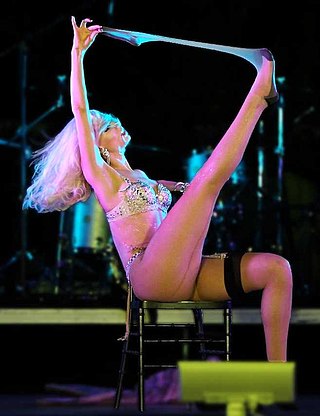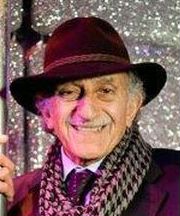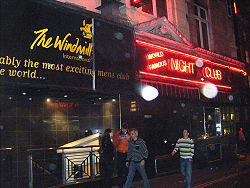
Soho is an area of the City of Westminster, part of the West End of London. Originally a fashionable district for the aristocracy, it has been one of the main entertainment districts in the capital since the 19th century.

A striptease is an erotic or exotic dance in which the performer gradually undresses, either partly or completely, in a seductive and sexually suggestive manner. The person who performs a striptease is commonly known as a "stripper" or an "exotic" or "burlesque" dancer.

Shaftesbury Avenue is a major road in the West End of London, named after The 7th Earl of Shaftesbury. It runs north-easterly from Piccadilly Circus to New Oxford Street, crossing Charing Cross Road at Cambridge Circus. From Piccadilly Circus to Cambridge Circus, it is in the City of Westminster, and from Cambridge Circus to New Oxford Street, it is in the London Borough of Camden.

The Odeon Luxe West End is a two-screen cinema on the south side of Leicester Square, London. It has historically been used for smaller film premieres and hosting the annual BFI London Film Festival. The site is on an adjacent side of the square to the much larger flagship Odeon Luxe Leicester Square.
Major Daniel Morris Angel was a leading British film producer who was responsible for several notable British films during the 1950s, such as Another Man's Poison (1952), The Sea Shall Not Have Them (1954), Reach for the Sky (1956), and Carve Her Name with Pride (1958).

Paul Raymond, born Geoffrey Anthony Quinn, was an English strip-club owner, publisher of pornography, and property developer who was dubbed the "King of Soho".

Mrs Henderson Presents is a 2005 biographical musical comedy-drama film directed by Stephen Frears and written by Martin Sherman. It stars Judi Dench, Bob Hoskins, Kelly Reilly, and Will Young. It tells the true story of Laura Henderson, an eccentric British socialite who opened the Windmill Theatre in London in 1931.

The Piccadilly Theatre is a West End theatre located at the junction of Denman Street and Sherwood Street, near Piccadilly Circus, in the City of Westminster, London. It opened in 1928.

The Raymond Revuebar (1958–2004) was a theatre and strip club at 11 Walker's Court, in the centre of London's Soho district. For many years, it was the only venue in London that offered full-frontal, on-stage nudity of the sort commonly seen in other cities in Europe and North America. Its huge brightly lit sign declaring it to be the "World Centre of Erotic Entertainment" made the Revuebar a local landmark.
Fiona Richmond is an English former glamour model and actress who appeared in numerous risqué plays, comedy revues, magazines and films during the 1970s. She became Britain’s best-known sex symbol and she has been described as one of the "two hottest British sex film stars of the seventies", the other being Mary Millington.

Laura Henderson born Laura Forster, rose to prominence during the 1930s when, as a wealthy and eccentric widow, she founded the Windmill Theatre in London's Great Windmill Street, in partnership with Vivian van Damm. Under the leadership of Henderson, as owner, and van Damm as manager, the theatre became a British institution, famed for its pioneering tableaux vivants of motionless female nudity, and for having "never closed" during the Blitz.
Vivian Van Damm was a prominent British theatre impresario from 1932 until 1960, managing the Windmill Theatre in London's Great Windmill Street. The theatre was famed for its pioneering tableaux vivants of motionless female nudity, and for its reputation of having 'never closed' during the Blitz.
Sheila van Damm was a British woman competitor in motor rallying in the 1950s, and also the former owner of the Windmill Theatre in London. She began her competitive driving career in 1950, and won the Coupe des Dames, the highest award for women, in the 1953 Alpine Rally. The following year she won the Women's European Touring Championship and, in 1955, the Coupe des Dames at the Monte Carlo Rally.

Murder at the Windmill, titled Mystery at the Burlesque in the United States, is a 1949 British crime film directed by Val Guest and featuring Garry Marsh, Jon Pertwee, Jack Livesey, Eliot Makeham and Jimmy Edwards.

Great Windmill Street is a thoroughfare running north–south in Soho, London, crossed by Shaftesbury Avenue. The street has had a long association with music and entertainment, most notably the Windmill Theatre, and is now home to the Ripley's Believe It or Not! museum and the Trocadero shopping centre.
Michael Klinger was a British film producer and distributor. After Tony Tenser, then a publicist became his business partner, the two men created the Compton cinema chain and distribution company and financed Repulsion (1965) and Cul-de-sac (1966) both directed by Roman Polanski. After their association ended, Klinger produced Get Carter (1971), starring Michael Caine, and Gold (1974), with Roger Moore in the lead, and was the executive producer of the 'Confessions' series of sex comedies with Robin Askwith.
Joan Jay was a singer and dancer at the Windmill Theatre in London, from 1936 to 1947. She was seriously injured there during a World War II bombing raid in October 1940, but returned to dancing after receiving skin grafts during a four-month stay in hospital. Her costumes were adapted to hide her scars.

Mrs Henderson Presents is a musical comedy with music by George Fenton and Simon Chamberlain, with lyrics by Don Black and a book by Terry Johnson. Based on the 2005 film Mrs Henderson Presents, the musical received its world premiere at the Theatre Royal, Bath in 2015 and transferred to the West End's Noël Coward Theatre in February 2016. The film was based on the true story of Laura Henderson and London's Windmill Theatre.

Oscar Manuel Owide was a British businessman, who ran nightclubs, restaurants and sex industry businesses over a long career. He was the proprietor of Soho's Windmill Theatre, which he ran with his son Daniel Owide as the Windmill International, a "gentleman's club", offering adult cabaret, table and lap dancing. The Evening Standard in 2004 said Owide was once "Britain's biggest pimp".














